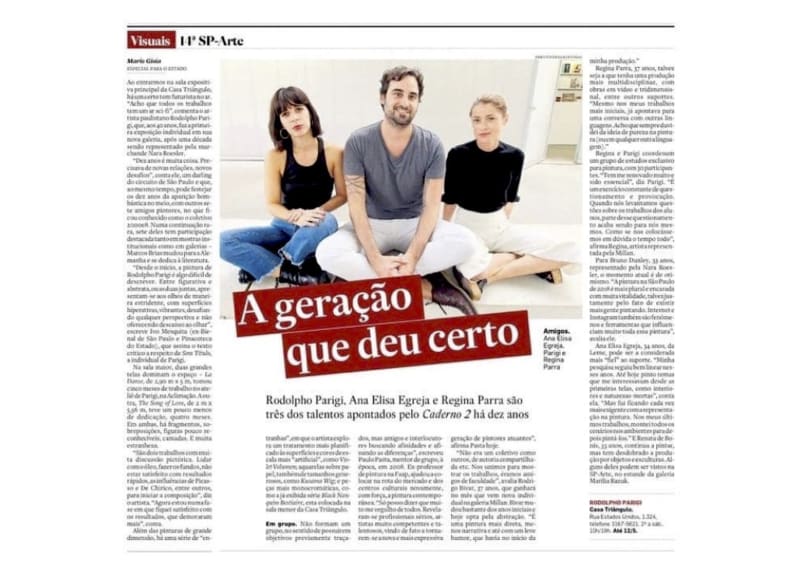Rodolpho Parigi, Ana Elisa Egreja and Regina Parra are three of the talents appointed ten years ago
As we enter the main exhibition hall of the Casa Triangulo, there is a certain futuristic tone to the air. “I think all works have a sci-fi feel,” says São Paulo artist Rodolpho Parigi, who, at the age of 40, makes his first solo exhibition in his new gallery after a decade of being represented by the dealer Nara Roesler.
“Ten years is a lot. I needed new relationships, new challenges” he says, a Darling from the São Paulo circuit and who, at the same time, can celebrate the ten years of bombastic apparition in the field, with other painter friends, in what became known as the 2000e8 collective. In a rare sequel, seven of them have featured prominently in both institutional exhibitions and galleries - Marcos Brias moved to Germany and devoted himself to literature.
“From the beginning, Rodolpho Parigi's painting is hard to describe. Between figurative and abstract, or both together, they are strident to the eye, with hyperactive, vibrant surfaces, defying any perspective and offering no rest to look at” writes Ivo Mesquita (former São Paulo Biennial and Pinacoteca do Estado), who signs the critical text on “Untitled,” Parigi's solo.
In the larger room, two large canvases dominate the space - La Danse, 2.90m x 5m, took five months of work at the Parigi studio in Aclimação. The other, The Song of Love, 2m x 5.56m, had a little less dedication, four months.
In both there are fragments, overlaps, unrecognizable figures, layers. And a lot of weirdness.
“These are two works with a lot of pictorial discussion. Dealing with oil, making backgrounds, not being satisfied with quick results, the influences of Picasso and De Chirico, among others, to start the composition” says the artist. “Now I'm at a stage where I am pleased with the results, which took longer” he says.
In addition to the large-scale paintings, there is a series of “guts” in which the artist explores a more flattened treatment of more “artificial” scale surfaces and colors, such as Violet Volumen; generously sized paper watercolors such as Kusama Wig; and more monochromatic pieces, such as the already exhibited Black Nanjing Bestiaire series, are placed in the smaller room of the Casa Triângulo.
“They are not a group in the sense that they have previously set goals, but friends and interlocutors seeking affinities and affirming differences,” wrote Paulo Pasta, the group's mentor at the time, in 2008. Former Faap painting teacher helped put the route of the market and the cultural centers back, with force, the contemporary painting. “I can only say that I am very proud of everyone. They turned out to be serious professionals, very competent and talented artists, in fact becoming the new and most expressive generation of painters” says Pasta today.
“It was not a collective like others, shared authorship, etc. We came together to show the work, we were college friends” says Rodrigo Bivar, 37, who will have next month a new solo show at the Galeria Millan. Bivar has changed a great deal from the early years and today opts for abstraction. “It's a more direct, less narrative, and even slightly humorous painting that was at the beginning of my production.”
Regina Parra, 37, is perhaps the one with a more multidisciplinary production, with video and three-dimensional works, among other media. “Even in my early work, I already pointed to a conversation with other languages. I think I've always doubted the idea of purity in painting (or any other language). ”
Regina and Parigi coordinate a study group exclusively for painting, with 30 participants. “It has renewed me a lot and been essential,” says Parigi. “It is a constant exercise of questioning and provocation. When we raise questions about student work, part of that question turns out to be for ourselves ” says Regina, an artist represented by Galeria Millan.
For Bruno Dunley, 33, represented by Nara Roesler, the current moment is optimistic. “Painting in São Paulo in 2018 is more plural and viewed with more vitality, perhaps precisely because there are more people painting. Internet and Instagram are also phenomena and tools that greatly influence all this painting” he says.
Ana Elisa Egreja, 34, from Leme, may be considered the most “loyal” to painting. “My research has been very linear over the years. To this day I paint themes that mattered from the earliest screens, such as interiors and still lifes, ”she says. “But I got more and more demanding with the representation in painting. In my last works, I set up all the scenarios in the environments and then painted them”.
And Renata de Bonis, 33, continues to paint, but has been developing the production by objects and sculptures. Some of them can be seen at SP-Arte, at the Marilia Razuk gallery booth.
